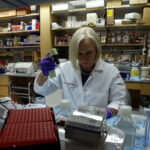A Conversation with Vera Krymskaya, PhD, MBA, Scientific Director

Dr. Vera Krymskaya has been appointed Scientific Director at The LAM Foundation after serving as interim since July 2023. She is the first female PhD Professor of Medicine at the Perelman School of Medicine, University of Pennsylvania. Dr. Krymskaya has made groundbreaking advances in basic and translational research that transformed the current understanding of two rare diseases, pulmonary lymphangioleiomyomatosis (LAM) and Birt-Hogg-Dube syndrome. We recently interviewed Dr. Krymskaya to learn more about her incredible journey from Ukraine to becoming a leading scientist in LAM research.
This interview is edited for length and clarity.
TLF: You have a fascinating life story. Tell me how you got from Ukraine to the University of Pennsylvania—before you began LAM research.
VK: Indeed, life is an adventure. My journey began in a small town in West Ukraine. After graduating from high school as valedictorian, I studied concert piano at a music conservatory. I subsequently pursued an MBA in marketing management, after which I entered graduate school at the Institute of Biophysics Russian Academy of Sciences. I completed my postdoctoral training in vascular diseases at the Cardiovascular Institute of the Russian Academy of Medical Sciences. In 1995, I was accepted at the University of Pennsylvania as a National Institutes of Health Visiting Scholar. There, I was offered a postdoctoral position at the Pulmonary, Allergy, and Critical Division at the University of Pennsylvania’s Department of Medicine.
 TLF: What led you to pursue the study of lymphangioleiomyomatosis (LAM)?
TLF: What led you to pursue the study of lymphangioleiomyomatosis (LAM)?
VK: In 2001, I was offered a faculty position at the Perelman School of Medicine at the University of Pennsylvania. However, to open my own laboratory, I needed to establish an independent avenue of research. I was particularly interested in diseases characterized by abnormal growth and smooth muscle-specific protein expression. This ultimately steered me towards lymphangioleiomyomatosis (LAM), a disease characterized by the abnormal growth of LAM cells.
TLF: How did you connect with The LAM Foundation?
VK: Once I decided that my future was in LAM research, I reached out to Sue Byrnes, founder of The LAM Foundation, and Dr. Frank McCormack, founding Scientific Director. I remember feeling tremendously honored and excited to speak with them. Dr. McCormack shared several insights on recent developments in LAM science, including a key publication linking the TSC2 mutation to LAM by Dr. Lisa Henske and Dr. Cheryl Walker’s work isolating TSC2-null cells from animal models to study LAM. And so commenced my journey into the realm of LAM research. I am so grateful to Drs. McCormack, Henske, and others who introduced and welcomed me into what has become my life’s most meaningful work. It is humbling to realize that The LAM Foundation is the vehicle that made those foundational connections and relationships possible for me.
TLF: What have been the most exciting moments so far in your LAM research?
VK: As a researcher, sometimes you produce unexpected results, and you need to keep testing to make sure those results are valid. I dedicated several months to replicating experiments to verify the link between the dysfunction of the TSC2 gene and the development of LAM. Other pivotal moments in my journey included dissecting LAM cells from a post-transplant lung for the first time in 2001, and engaging with LAM patients. It’s always amazing to meet the actual LAM patients to whom I have dedicated my research.
TLF: What does the role of The LAM Foundation Scientific Director mean to you?
VK: I have been privileged to be involved with The LAM Foundation for 23 years—serving the LAM community has been one of the great joys of my life. The rapid pace of discoveries in LAM has not only impressed the scientific community but has also significantly alleviated suffering for many individuals. The LAM Foundation has been a driving force, representing LAM patients and investing every dollar raised in impactful ways. I truly view the work of The LAM Foundation and LAM scientists as a collective endeavor fueled by a shared commitment to extend the life span and enhance the quality of life for women living with this devastating disease. As a researcher, it can be easy to lose sight of the lived experiences of those affected by LAM. Therefore, maintaining the patient voice at the core of our work, whether in the laboratory or clinic, is crucial. This is one of the many reasons why The LAM Foundation is essential for advancing LAM science.